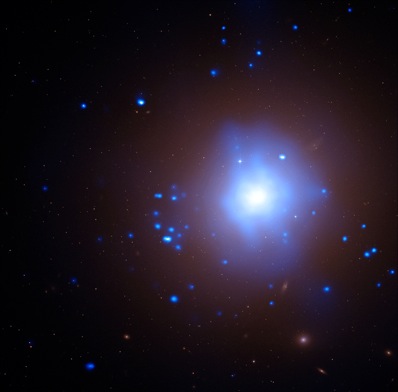
Rare black hole munches
on white dwarf
KEITH COOPER
ASTRONOMY NOW
Posted: 04 January 2010


A rarely seen intermediate mass black hole, at least 1,000 times more massive than our Sun, has been caught tearing apart a white dwarf star and swallowing the debris, according to astronomers using NASA’s Chandra X-ray Observatory and the Magellan telescopes in Chile.
 The elliptical galaxy NGC 1399 in the Fornax galaxy cluster plays host to a globular cluster with a powerful X-ray source. This is a composite X-ray/optical light image. X-ray image: NASA/CXC/UA/J Irwin; optical image: NASA/STScI. The elliptical galaxy NGC 1399 in the Fornax galaxy cluster plays host to a globular cluster with a powerful X-ray source. This is a composite X-ray/optical light image. X-ray image: NASA/CXC/UA/J Irwin; optical image: NASA/STScI.
This cataclysmic event was first spotted by Chandra inside an ancient globular cluster orbiting the elliptical galaxy NGC 1399, 65 million light years away. The X-ray source that it detected was so bright that it outshines anything of stellar mass, but isn’t bright enough to be a supermassive black hole like those at the centre of galaxies. The only other logical explanation is a middle-mass black hole, the existence of which are hotly contested and for which only a few have been found.
To be shining brightly in X-rays, the black hole must be feeding on something. When the astronomers searched the scene of the crime using the 6.5-metre Magellan telescopes run by a consortium of US-based universities, they detected in the optical spectra the telltale signatures of oxygen and nitrogen, but no hydrogen. This is an odd combination to find in a globular cluster full of ancient, hydrogen-rich but metal poor stars, and leads to only one solution.
“We think these unusual signatures can be explained by a white dwarf that strayed too close to a black hole and was torn apart by the extreme tidal forces,” says Joel Bregman of the University of Michigan, a co-author on the study. White dwarfs are the evolved remains of Sun-like stars, which have cast off their hydrogen-rich outer layers to reveal inner cores of containing lots of oxygen. However, the abundance of nitrogen in the spectra is still a puzzle, admit the researchers.
As the white dwarf wandered close to the black hole in the densely packed globular cluster, the gravitational tidal forces began to tear it apart. The X-ray emission is coming from the debris of the white dwarf that has fallen very close to the black hole and is being heated through friction as it spirals around the event horizon. The material visible in optical light is coming from debris further out that is being illuminated by the X-rays. In fact, the researchers expect it to continue to shine in X-rays for the rest of the century, although they did monitor a 35 percent dip in the light between the years 2000 and 2008.
|



